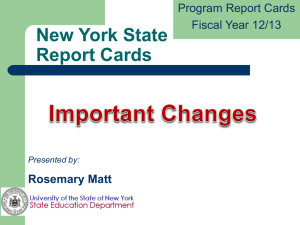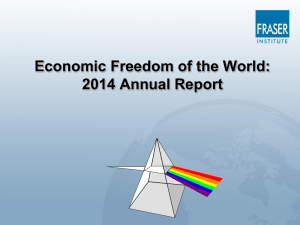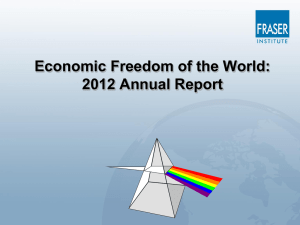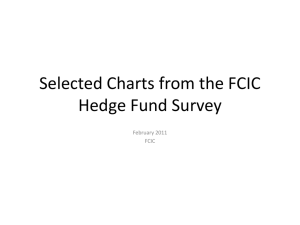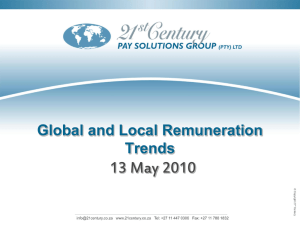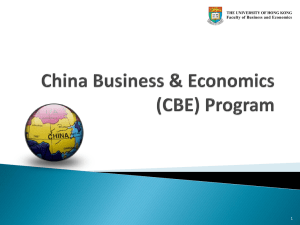Institutions & Poverty
advertisement
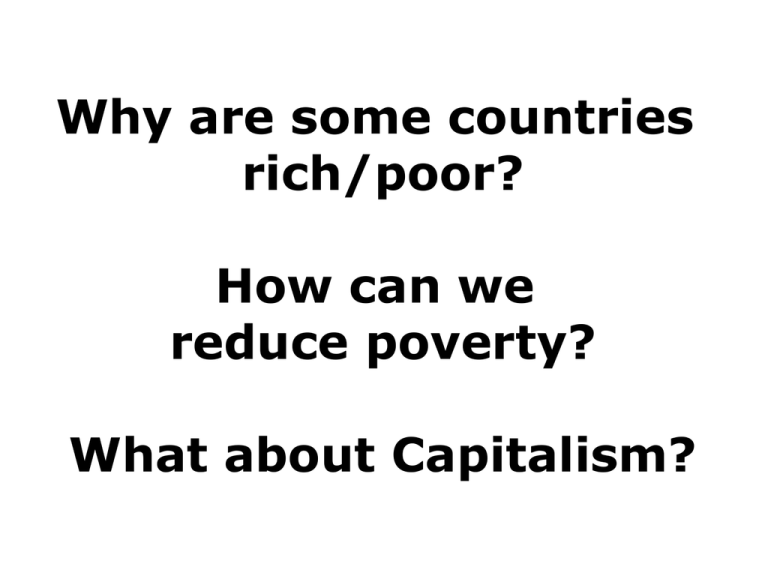
Why are some countries rich/poor? How can we reduce poverty? What about Capitalism? Joke of the Evening Why are some countries rich/poor? How can we reduce poverty? What about Capitalism? The Wealth of Nations Real Gross Domestic Product Per Capita (1990 $) 1000 1500 1700 1820 1900 1952 2003 $427 $772 $997 $1,202 $2,892 $4,963 $19,912 USA 527 1,257 4,091 10,316 29,037 India 550 533 599 629 2,160 2008 Area Western Europe China 450 600 600 600 545 537 4,609 Africa 425 414 421 420 601 928 1,549 World 450 566 615 667 1,262 2,260 6,477 21,672 31,178 2,975 6,725 1,780 7,614 Sources: Development Centre Studies The World Economy: Historical Statistics, Maddison 2003. World Population, GDP and Per Capita GDP, 1-2003 AD, Maddison, 2007, http://www.ggdc.net/maddison/ and http://www.ggdc.net/MADDISON/oriindex.htm for 2008 data Economics for Leaders Source: World Bank Poverty Data www.worldbank.org Poverty Fact The number of extreme poor has declined by 740 million since 1981 What factors contributed to this decline? Source: World Bank Poverty and Inequality Database http://databank.worldbank.org/Data/Views/Reports/TableView.aspx (April 30, 2012) Economics for Leaders Some Good News in Africa Source: World Bank Poverty and Inequality Database http://databank.worldbank.org/Data/Views/Reports/TableView.aspx (April 30, 2012) Institutions Matter Let’s define CAPITALISM as having the RIGHT INSTITUTIONS in place. Rule of Law Private Property Rights Open, Competitive Markets Entrepreneurship and Innovation Institutions Shape Incentives Douglass North Nobel Prize in Economics 1993 Economics for Leaders Institutional Variation Measurement: Fraser Institute Economic Freedom: Size of government and taxation Protection of private property and the rule of law Soundness of money Trade regulation and tariffs Regulation of business, labor and capital markets Economics for Leaders 32 Background: Economic Freedom Project 25 year project Transparency is a highly valued part of the project Based entirely on third party data from World Bank, International Monetary Fund (IMF), Global Competitiveness Report, etc. (based on both objective and survey data) They rank 144 countries representing 95% of the world’s population according to the extent to which they permit their citizens to be economically free Economics for Leaders 33 World Average Economic Freedom Over Time 8 4 6.8 9 6.7 0 6.8 6 6.8 3 6.8 9 6.7 9 6.5 2 6.1 6 5.6 5 5.3 0 5.3 1 5.3 6 9 5.8 Economic Freedom Score 10 4 2 0 1970 1975 1980 1985 1990 1995 2000 2005 2006 2007 2008 2009 2010 Economics for Leaders Source: The Fraser Institute, 2012 Per Capita Income and Economic Freedom Quartile GDP Per Capita (ppp), 2011 $40,000 $35,000 $30,000 $25,000 $20,000 $15,000 $10,000 $5,000 $0 Most Free Quartile 2nd Quartile 3rd Quartile Least Free Quartile Most Free ……………. Least Free Economics for Leaders Sources: The Fraser Institute; The World Bank, World Development Indicators, 2013 Growth in Developing Nations Per Capita and Economic Freedom Quartile Growth GDP per capita (average annual %), 19912011 % 4.0 3.5 3.0 2.5 2.0 1.5 1.0 0.5 0.0 Most Free Quartile 2nd Quartile 3rd Quartile Least Free Quartile Most Free ……………. Least Free Sources: The Fraser Institute; The World Bank, World Development Indicators, 2013. Economics for Leaders Growth GDP per capita (average annual %), 1991-2011 Income Share of the Poorest 10% and Economic Freedom 3.0% 2.5% 2.0% 1.5% 1.0% 0.5% 0.0% Most Free Quartile 2nd Quartile 3rd Quartile Least Free Quartile Most Free ……………. Least Free Sources: The Fraser Institute; The World Bank, World Development Indicators, 2013. Economics for Leaders Income of the Poorest 10% and Economic Freedom Income of the Lowest 10%, 1990-2010 $12,000 $10,000 $8,000 $6,000 $4,000 $2,000 $0 Most Free Quartile 2nd Quartile 3rd Quartile Least Free Quartile Most Free ……………. Least Free Sources: The Fraser Institute; The World Bank, World Development Indicators, 2012. Economics for Leaders Economics for Leaders Consider the “slice of pie” Economics for Leaders Source: World Development Indicators, 2011. Economic Freedom and Poverty Economics for Leaders Life Expectancy at Birth and Economic Freedom Quartiles 85 Years 75 65 55 45 Most Free Quartile 2nd Quartile 3rd Quartile Least Free Quartile Most Free ……………. Least Free Sources: The Fraser Institute; The World Bank, World Development Indicators, 2013. Economics for Leaders Economic Freedom and Quality of Health Care, 2009 Economics for Leaders Literacy & Economic Freedom Quartiles (% of population) Male Female 100 90 80 70 60 50 Most Free Quartile 2nd Quartile 3rd Quartile Least Free Quartile Most Free ……………. Least Free Sources: The Fraser Institute; World Development Indicators 2013 Economics for Leaders Economic Freedom and Educational Quality, 2009 Economics for Leaders Economic Freedom and Political Rights Low scores indicate high level of rights Political Rights (out of 7) 5.0 4.0 3.0 2.0 1.0 0.0 Most Free Quartile 2nd Quartile 3rd Quartile Least Free Quartile Most Free ……………. Least Free Economics for Leaders Sources: The Fraser Institute; Freedom House, Freedom in the World Country Ratings, 2013, available at http://www.freedomhouse.org/. Economic Freedom and Civil Rights Low scores indicate high level of rights 5.0 Civil Liberties (out of 7) 4.0 3.0 2.0 1.0 0.0 Most Free Quartile 2nd Quartile 3rd Quartile Least Free Quartile Most Free ……………. Least Free Economics for Leaders Sources: The Fraser Institute; Freedom House, Freedom in the World Country Ratings, 2013, available at http://www.freedomhouse.org/. Economic Freedom and Corruption Corruption Rating (out of 100) High scores indicate low corruption 100 90 80 70 60 50 40 30 20 10 0 Most Free Quartile 2nd Quartile 3rd Quartile Least Free Quartile Most Free ……………. Least Free Sources: The Fraser Institute; Transparency International, Corruption Perceptions Index, 2012 available at http://www.transparency.org. Economics for Leaders Overall Economic Freedom Index and the Bottom 10 Mozambique Chad Algeria Guinea-Bissau Congo, Dem. R. Angola Congo, Rep. Of Zimbabwe Myanmar Venezuela 0 Economics for Leaders 2 4 6 8 10 Score (out of 10) Source: The Fraser Institute, 2012 The Big Picture Until the 1750’s extreme poverty was the standard for all of human history. Since 1750 economic growth has lifted large sections of humanity to levels of wealth unheard of previously. The engine of economic growth is reducing poverty rates worldwide. Capitalism consists of institutions that help promote economic growth. Economics for Leaders Available to % of non-poor people in U.S. population Available to % of poor people in U.S. population Refrigerator 99.4 98.5 Stove 99.1 97.0 Color television 99.1 97.4 Telephone 91.9 79.8 Washing machine 86.2 68.7 Clothes dryer 83.8 61.2 Microwave 97.1 91.2 Dishwasher 67.5 36.7 Freezer 38.1 25.1 VCR 93.3 83.6 Air conditioner 86.6 78.8 Personal computer 70.2 42.4 Consumer durables Source: U.S. Census Bureau, Survey of Income and Program Participation, 2004 Panel, Wave 5 Internet Release date: November, 2009. Economics for Leaders Hans Rosling 200 Countries 200 Years, 4 minutes http://www.youtube.com/watch?v=jbkSRLYSojo Economics for Leaders The Two Dollar Challenge What is Challenge Week? Live on two dollars a day and follow other RULES for a week, and record your experiences for others to read. Fundraise for economic development as you abstain from purchasing goods. Why Participate Begin to understand firsthand the hardship that half the world's population endures. Nurture a new respect for impoverished persons. Participants have many reactions throughout Challenge Week as demonstrated in these blog entries from past years. Students face additional, unexpected obstacles and struggle with the emotional discomforts of "playing poverty." http://www.twodollarchallenge.org/
